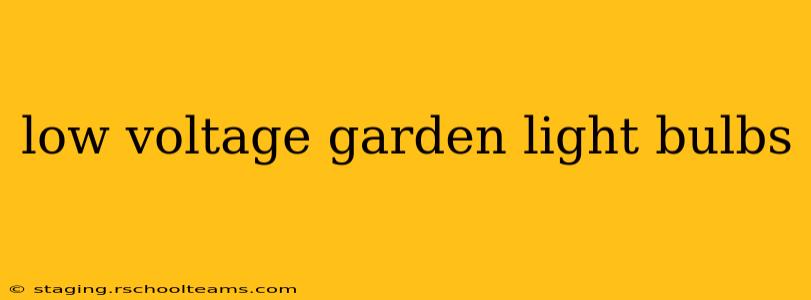Low voltage garden lighting offers a beautiful and safe way to illuminate outdoor spaces. But choosing the right bulbs can be tricky. This guide will explore everything you need to know about low voltage garden light bulbs, helping you select the perfect illumination for your landscape.
What are Low Voltage Garden Lights?
Low voltage garden lighting systems operate at 12 volts or less, significantly lower than standard household voltage (120V in North America, 230V in Europe). This lower voltage makes them safer to install and use, especially near water features or in areas where accidental contact is possible. The reduced voltage also translates to lower energy consumption compared to traditional high-voltage options.
What Types of Low Voltage Garden Light Bulbs are Available?
Several types of bulbs are compatible with low voltage garden lighting systems. The most common include:
-
LED (Light Emitting Diode): LEDs are the most popular choice for low voltage landscape lighting. They are energy-efficient, long-lasting, and available in various colors and light temperatures (warm white, cool white, etc.). They also offer excellent durability, resisting vibration and shocks better than traditional incandescent bulbs.
-
Halogen: Halogen bulbs produce a brighter, warmer light than LEDs, but they are less energy-efficient and have a shorter lifespan. They are gradually being phased out in favor of LEDs due to their higher energy consumption.
-
Incandescent: While less common now due to their inefficiency, some older low-voltage systems might use incandescent bulbs. These are generally not recommended for new installations due to their high energy use and short lifespan.
What are the Advantages of Using Low Voltage Garden Light Bulbs?
The advantages of using low voltage garden light bulbs are numerous:
- Safety: The lower voltage significantly reduces the risk of electric shock.
- Energy Efficiency: LEDs, in particular, consume far less energy than traditional bulbs, lowering your electricity bill.
- Ease of Installation: Low voltage systems are generally easier to install than high voltage systems, often requiring less technical expertise.
- Durability: Many low voltage bulbs, especially LEDs, are built to withstand the elements and last for many years.
- Design Flexibility: Low voltage systems allow for creative lighting designs with a variety of fixtures and placements.
What is the Difference Between Low Voltage and High Voltage Garden Lights?
The primary difference lies in the voltage. High voltage systems operate at standard household voltage, posing a greater safety risk. Low voltage systems use transformers to step down the voltage, making them safer. High voltage systems generally require more expertise for installation. Energy efficiency varies depending on the bulb type used in either system, but LEDs in low-voltage systems tend to be more energy-efficient overall.
How Long Do Low Voltage Garden Light Bulbs Last?
The lifespan of a low voltage garden light bulb depends heavily on the bulb type. LEDs typically last for 50,000 hours or more, while halogen bulbs might last for 2,000-4,000 hours. Incandescent bulbs have the shortest lifespan, often lasting only a few hundred hours.
How Much Do Low Voltage Garden Light Bulbs Cost?
The cost of low voltage garden light bulbs varies depending on the type, wattage, and features. LEDs tend to be more expensive upfront but are offset by their longer lifespan and lower energy consumption. Halogen bulbs are generally cheaper initially but more expensive to run in the long term.
Are Low Voltage Garden Lights Waterproof?
Not all low voltage garden lights are waterproof. Check the IP rating (Ingress Protection rating) of the bulb and fixture to ensure they are suitable for outdoor use. A higher IP rating indicates better protection against water and dust. Look for an IP rating of at least IP65 for outdoor applications.
How to Choose the Right Low Voltage Garden Light Bulbs?
Choosing the right bulbs depends on your needs and preferences:
- Consider the light output (lumens): Higher lumens mean brighter light.
- Select the appropriate color temperature (Kelvin): Warm white (2700-3000K) creates a cozy ambiance, while cool white (5000-6500K) provides brighter, more energizing light.
- Choose energy-efficient LEDs for long-term cost savings.
- Check the IP rating to ensure suitability for outdoor use.
- Match the bulb base to your fixture.
By understanding the various types of low voltage garden light bulbs and their characteristics, you can select the perfect illumination to enhance the beauty and safety of your outdoor space. Remember to always prioritize safety and choose bulbs and fixtures with appropriate IP ratings for outdoor use.
